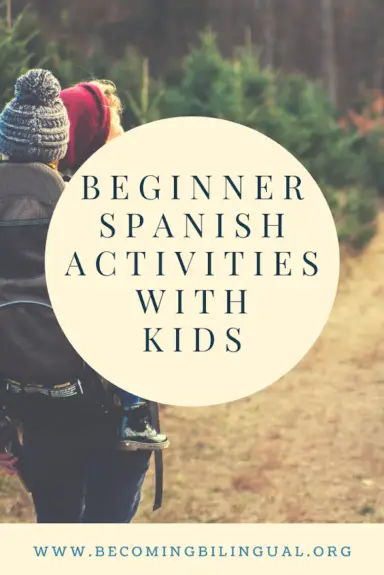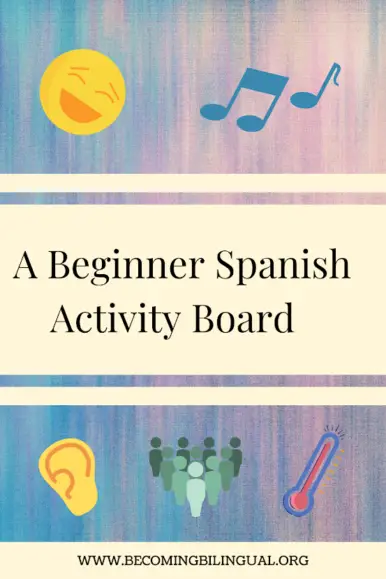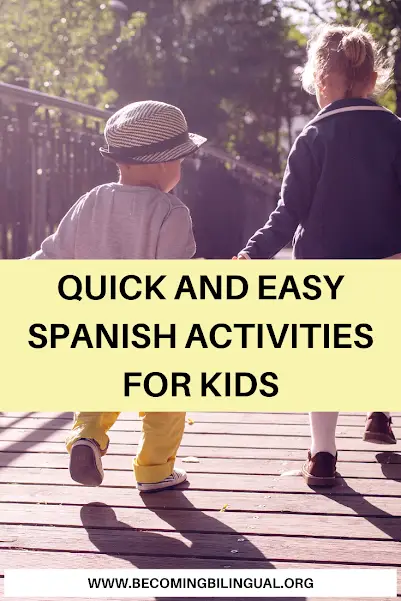Quick And Easy Spanish Activities For Kids

Last Updated on January 18, 2021 by Reina Victoria
As my daughter’s main source of Spanish, I am always looking for activities that we can do around our home to promote the use of Spanish language.
Especially now that the school year has started, we’ve gotten into a pattern of doing the same things everyday. Each afternoon we play outside for a bit, do dinner, clean up and then bedtime. I find myself saying similar things to my daughter each day.
Since I’m always looking to push for more and varied vocabulary, I created some activities that we could easily do around the house to promote more Spanish speaking time across a variety of topics.

Table of Contents
1. What Do You Hear?
Go outside. Close your eyes and listen quietly to all of the things that you hear. Can you hear three different things? Can you hear 5 different things?
Talking about what you hear around you is a great way to increase Spanish vocabulary for the most common objects that are in and around your home. It’s also a great way to practice some basic Spanish speaking and sentence structure.
You can encourage your child to answer with “Oigo” for example, “Oigo a bird”. If you and your child know the word for bird, encourage them to say, “Oigo un pajaro”. If you don’t know the word that you’re trying to say, look it up when you get back home and try and work that new vocabulary into the rest of your day.
You can play this game when you’re in the car, when you go someplace new, or even in your home. Stopping to listen to the things around you, while also making more time for Spanish speaking practice is a great addition to your day!
2. Music Time!
Listen to one song in Spanish and try to sing along! Music is one of the easiest and most natural ways to learn a language, since the rhythm of lyrics make the words easier to remember.
There are so many great songs that are available in Spanish and many more that are becoming easily accessible on sites like Amazon Music and iTunes. It’s easy to find something that you and your family will enjoy.
We love our Disney music here, so we subscribe to Amazon Music and create playlists with our favorite Disney songs. Check out our favorites here!
If you have younger children, starting with nursery rhymes is a great way to introduce basic Spanish phrases and vocabulary.
Spanish music is a great on-the-go option since you can easily listen to Spanish songs in the car. We like to have a playlist of Spanish songs that we can use in the car, even if we’re just running out for a quick errand.

3. What’s The Temperature?
Whether you’re outside, watching the weather, or looking out the window, weather is a great way to practice some Spanish speaking.
You can start with basic phrases like, “Hace calor” (It’s hot) or “Hace frio) for when it’s cold. You can make a point to talk about the weather each day so that you expand your vocabulary as the seasons change and track weather patterns as a family.
If you want to add on to the activity, you can talk about what kinds of clothes to wear to match the daily weather. Using phrases like, “Hoy necesitas una chaqueta” (Today you need a coat).
Just starting out on your Spanish language journey? Take a look at this infographic that has some great weather words and phrases to get you started.
4. Count The People
Counting is a great way to build your Spanish number vocabulary. When my daughter was younger we counted everything! This reinforces counting and 1:1 correspondence skills, and also gives a foundations for numbers in Spanish.
We have stairs in our home, so each day we’d count the stairs as we climbed up and down them. As my daughter was able to count to higher and higher numbers, we started to count groups of things.
Counting the people is a great activity to do when you go out somewhere and you have a minute of down time. Waiting for a seat at a restaurant? Count the people in line. Count the people at the next table. Count the waitresses that you see. At the park? Count the number of people on the playscape. Count the number of people walking dogs.
Counting is a simple way to get more Spanish into your day.

5. Make Silly Faces!
My daughter and I like to take pictures together where we model different expressions – sad faces, goofy faces, happy faces, angry faces, etc. Emotion words are great beginning vocabulary words to teach children since we encounter them often on other people, in ourselves and in the pictures of the books we read.
You and your child can alternate making faces and guessing the emotion of the other person. If you don’t know the word in Spanish say, “Me siento sad” and then look up the Spanish word later to practice.
This is a good activity to try when flipping through a picture book, too. So many of the characters have easily identifiable expressions on their faces. You can prompt with, “Donde esta la persona feliz?” (Where’s the happy person?) or “Encuentra alguien enfadado” (Find someone who’s angry).
This activity is also fun to do with chalk outside. You can practice drawing faces with the chalk that match different expressions and then label them.

None of these activities require materials and almost all of them can be done in and around the house. Learning Spanish doesn’t have to be an expense and it can be reinforced all throughout the day with the things that you and your family naturally do.
When you’re learning a new language, the most important thing is to work on it daily and to use it consistently. If you’re looking for more lists of Spanish activities like this, check out Spanish Mama’s list here to get some more ideas!
101 Easy Spanish Activities For Kids Stuck At Home
Through constant immersion from a variety of resources, I was able to bring native Spanish language to my daughter even though I didn’t speak it fluently. With great resources you can raise a bilingual child, too!
Happy Learning!
Don’t forget to subscribe here and get my latest posts and resources delivered directly to your inbox!